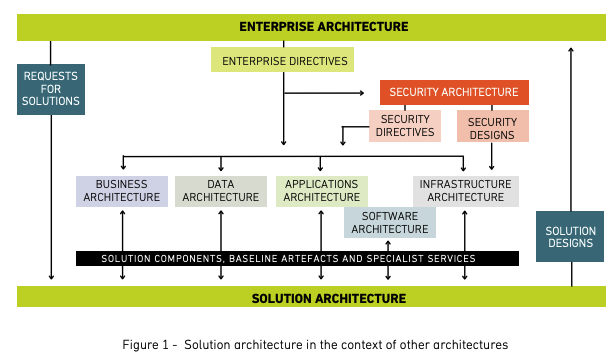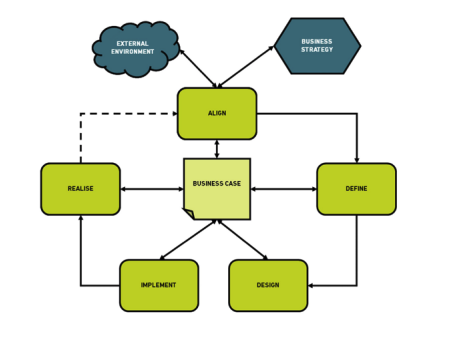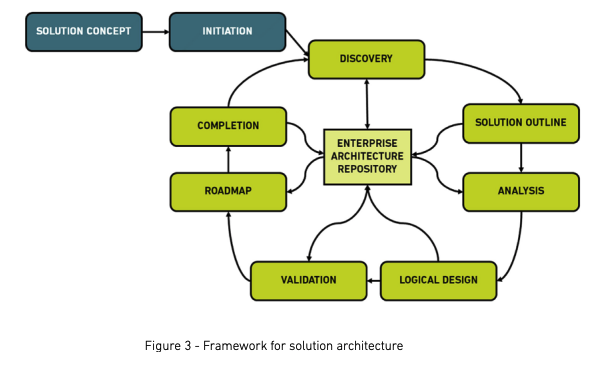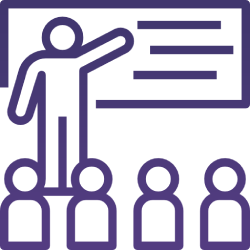Please Note: You can book this course and hold it in credit until you have decided on a specific course date. Alternatively, please view our other course dates
Please Note: You can book this course and hold it in credit until you have decided on a specific course date. Alternatively, please view our other course dates
Our BCS Practitioner Certificate In Enterprise & Solutions Architecture V5.0 training course will give you an in-depth understanding of the role of architecture in an organisation, including key frameworks, lifecycles, artefacts and activities required of successful architecture.
Upon completion of our BCS Practitioner Certificate In Enterprise & Solutions Architecture V5.0 training course, you will be able to demonstrate a practical understanding of:
Our BCS Practitioner Certificate In Enterprise & Solutions Architecture V5.0 training course will cover the following topics:
1. ARCHITECTURE DOMAINS AND FRAMEWORKS
1.1 Discuss the role of architecture in an organisation.
Indicative Content
a. Definition ”fundamental concepts or properties of a system in its environment embodied in its elements, relationships, and in the principles of its design and evolution” ISO 42010.
b. The need for architecture.
c. Drivers for architecture:
• Strategic change.
• Problem solving.
• Legal requirements.
d. Purpose and scope of own role.
Guidance
Candidates should discuss what architecture is, and the reason it is required in organisations. The drivers for architecture may be both internal and external, and candidates should be able to describe these drivers and the effect they have on specific domains. Candidates should be able to explain the purpose and scope of the role of an architect, in a given domain.
1.2 Discuss the different architecture domains and the relationships between them.
Indicative Content
a. Architecture domains:
• Enterprise.
• Business.
• Applications.
• Solution.
• Software.
• Infrastructure.
• Data.
• Security.
b. Key activities and artefacts in each domain area.
c. Dependencies between domains.
Guidance
Candidates should discuss the role of each architecture domain and the dependencies and relationships between them. The main activities and purpose of each domain should be considered, as well as the role each plays in the organisation.

1.3 Discuss the key architecture frameworks.
Indicative Content
a. Architecture frameworks:
• Zachman Framework.
• The Open Group Architecture Framework (TOGAF).
• NATO Architectural Framework (NAF).
• C4 Model.
b. Security frameworks:
• The Cyber Security Body of Knowledge (CyBOK).
• Sherwood Applied Business Security Architecture (SABSA).
Guidance
Candidates must be able to discuss the architecture and security frameworks on this list only. Candidates should be able to describe the application of these frameworks and how they impact architecture activity.
1.4 Discuss how industry standards are relevant to architecture.
Indicative Content
a. ISO standards:
• ISO 42010 (Systems and software engineering – architecture description).
• ISO 9241-11 (Ergonomics of human system interaction).
• ISO 27000 series (Information security management systems).
• ISO 15704 (Enterprise modelling and architecture).
• ISO 14000 series (Environmental management).
• ISO 25000 series (System and software quality requirements and evaluation).
• ISO 38500 (Corporate governance of IT).
b. Relevant bodies of knowledge:
• Data Management Body of Knowledge (DMBOK).
• Business Architecture Body of Knowledge (BIZBOK).
• Business Architecture Technology Body of Knowledge (BTABoK).
c. National Institute of Standards and Technology
Cyber Security Framework (NIST).
d. National Cyber Security Centre (NCSC) CYBOK.
Guidance
Candidates must be able to discuss the industry standards on this list only. Candidates shall give examples of how these standards are considered as guidance for ways of working, how they are applied in practice and the impact they have on architecture activities.
2. ARCHITECTURE AND THE ORGANISATION
2.1 Explain the role of architecture to other business areas.
Indicative Content
a. Organisation’s mission, vision and purpose.
b. Organisational strategy.
c. Organisational structure.
d. Other business functions:
• IT.
• People.
• Ops.
• Finance.
Guidance
Candidates should demonstrate their understanding of a business situation, linking it to the organisation’s strategy, mission, vision and purpose. They shall discuss the structure of the organisation and describe the relationship between architecture and other business areas.
2.2 Discuss use of the business change lifecycle as an input for architecture.
Indicative Content
a. Practical example of the lifecycle in use.
Guidance
Candidates should discuss the stages of the business change lifecycle and relate them to a given business situation.

2.3 Discuss the business needs and the intended solution.
Indicative Content
a. Problem statement.
b. Directive hierarchy.
• Principles, policies, business rules.
c. Target solution hierarchy.
• Solution outline, blueprint, to be built.
d. High level design.
Guidance
Candidates should discuss how the business needs have been established and considered when planning a solution, and how these are demonstrated in the high level design. The need to understand a problem statement, alongside the consideration or organisational principles, policies and business rules should be explained.
3. PROFESSIONALISM IN ARCHITECTURE
3.1 Discuss compliance with professional standards.
Indicative Content
a. BCS Code of Conduct.
b. Digital, Data and Technology Profession Capability Framework (DDaT).
c. Skills Framework for the Information Age (SFIA+).
Guidance
Candidates should discuss specific actions they can take to comply with the professional standards listed.
3.2 Discuss types of stakeholders.
Indicative Content
a. Stakeholder categories and management strategies.
b. Technical and non-technical roles.
c. Stakeholder communication plan.
Guidance
Candidates should describe the various stakeholders involved in a given project and identify potential ways to manage and work alongside them. Candidates shall identify the adjustments required to their own ways of working when communicating with technical versus non-technical stakeholders.
3.3 Explain specific stakeholder needs.
Indicative Content
a. Views and viewpoints.
b. Conflicting requirements.
Guidance
To address specific stakeholder concerns, viewpoints can be used to demonstrate the behaviour of certain parts of a solution that are of particular interest. Candidates should describe how different stakeholders may have conflicting ideas of requirements and how to address these.
3.4 Discuss how to influence others.
Indicative Content
a. Recognise the limits of own authority.
b. Contribute to business decision making.
c. Influencing outside of normal reporting lines.
d. Being a subject matter expert.
Guidance
Candidates should discuss the ways in which an architect must influence others, including using their own subject knowledge and expertise to advise senior staff outside of the normal hierarchy. Candidates shall discuss their understanding of when to seek help or escalate an issue which is beyond the limits of their authority.
3.5 Apply a practical customer focus.
Indicative Content
a. Identifying the customer needs.
• Use case diagrams.
• User stories.
b. UX/UI.
c. Accessibility.
d. Metrics of customer satisfaction.
Guidance
Candidates should explain steps and actions that can be taken to show a commitment to the customer throughout design and development of a solution. Candidates shall describe tools and metrics that can be used to measure the success of a solution and the level of customer satisfaction.
3.6 Discuss the roles and dynamics of a successful team.
Indicative Content
a. Agile roles.
b. Belbin’s team roles.
c. High performing teams.
Guidance
Candidates should discuss the key roles within Agile, and the characteristics of high performing teams. Candidates shall be able to categorise team members using Belbin’s team role descriptions.
3.7 Discuss social, ethical and economic concerns to the role of an architect.
Indicative Content
a. Ethics.
b. Green IT.
c. Corporate social responsibility.
d. Sustainable design.
e. Inclusive and accessible design.
Guidance
Candidates should discuss the practical steps that can be taken to demonstrate consideration of social, ethical and economic issues in architecture. The importance of inclusive and accessible design should be explored with examples given of how this is implemented.
4. CORPORATE GOVERNANCE
4.1 Explain corporate governance and the impact it has on the role of an architect.
Indicative Content
a. “Governance means controlling activity and decision making to ensure that the change delivered matches the specification agreed with the business.... through the use of processes and organisational structures”.
b. Different levels of governance between enterprise and solution.
c. Policy.
d. Processes.
e. Risks of non-compliance.
Guidance
Candidates should demonstrate their understanding of corporate governance, and the direct impact it has on the role of an architect. The need for consideration of and compliance with various policies and processes should be discussed, as well as the potential impact of noncompliance.
4.2 Discuss key architecture governance concepts, roles and artefacts.
Indicative Content
a. Concepts:
• Conformance level.
• Compliance level.
• Dispensation.
b. Roles:
• Architecture board.
• Governing architect.
• Design authority.
c. Artefacts:
• Compliance review.
• Compliance checklist.
• Capability maturity model.
Guidance
Candidates should discuss the application and use of the key concepts in architecture governance, and their purpose. The role of the architecture board and the accountability of the governing architect should be related to an organisational context.
4.3 Explain the importance of risk management to the role of an architect.
Indicative Content
a. Risk appetite.
b. Documenting risk.
Guidance
Candidates should discuss the importance of understanding the organisation’s risk appetite and the need for documentation to record any risks that have been identified and mitigations which have been implemented.
5. ARCHITECTURAL PROCESS, TOOLS AND VISION
5.1 Discuss the practical application of the solution architecture framework.
Indicative Content

Guidance
Candidates should describe the stages of the solution architecture framework, the key artefacts and activities of the architect at each stage.
5.2 Discuss three varieties of the Software Development Lifecycle (SDLC).
Indicative Content
a. Waterfall.
b. Iterative.
c. Agile.
Guidance
Candidates should discuss the practical application of each of the three varieties of the SDLC. Candidates should be able to critically compare the suitability of each lifecycle to a given scenario.
5.3 Discuss the design of a target solution architecture.
Indicative Content
a. Options evaluation.
b. Trade off analysis.
c. Modelling.
d. Design patterns:
• Data design patterns.
• Enterprise integration patterns.
• Business model patterns.
• Application integration patterns.
• Technology solution patterns.
Guidance
Candidates should discuss the activities undertaken by the architect during design, including how to analyse the possible options and suitability of design patterns.
5.4 Discuss the use of common architecture models.
Indicative Content
a. Business model.
b. Business motivation model.
c. Capability map.
d. Value stream map.
e. Functional decomposition.
f. Business process models.
Guidance
Candidates should discuss the purpose and application and desired output of the common architecture models listed. Candidates shall consider their suitability for use in a given scenario.
5.5 Discuss the use of common information systems modelling techniques
Indicative Content
a. Process models.
b. Data models.
c. Context diagrams.
d. Use case diagrams.
e. Data flow diagrams.
f. Interaction/sequence diagrams.
Guidance
Candidates should discuss the purpose and use of modelling techniques as listed. Candidates shall consider the applicability of each technique to a given scenario.
5.6 Explain different types of business requirements.
Indicative Content
a. Types of requirements:
• Business and IT strategy.
• Corporate governance.
• Enterprise architecture.
• Technical requirements.
• General business requirements
• Stakeholders.
• Functional requirements.
• Non-functional requirements (NFRs).
• Constraints.
b. Quality and characteristics of requirements.
c. INVEST:
• Independent.
• Negotiable.
• Valuable.
• Estimatable.
• Small.
• Testable.
Guidance
Candidates should discuss the different types of requirements, their origins and how to ensure quality.
5.7 Explain a method of preparing a gap analysis.
Indicative Content
a. Architecture descriptions.
b. The purpose of a gap analysis.
c. Grid method.
d. Table method.
e. Graph method.
f. Gap report.
g. Gap models.
Guidance
Gap analysis can be applied to identify differences, required improvements and planned growth between a current and desired state, or between two or more architecture descriptions. Candidates should discuss how to prepare a gap analysis, through the use of various tools and techniques.
5.8 Discuss a business case for presentation.
Indicative Content
a. The contents of a business case.
b. Cost benefit analysis, ROI, risk assessment, gap analysis.
c. Presenting information to non-technical stakeholders.
Guidance
Candidates should discuss the role of the architect in preparing the contents of a business case, including the artefacts and information required and the most suitable methods for presentation.
6. QUALITY ASSURANCE
6.1 Discuss the use of a range of quality assurance tools or techniques
Indicative Content
a. Delivery roadmap.
b. Comparison to Service Level Agreement (SLA).
c. Comparison against requirements.
d. Technical walkthroughs.
Guidance
Candidates should discuss the use of the tools listed as means of assuring the quality of a solution. Requirements, SLA and delivery roadmap can be used to compare the solution being delivered to the needs and expectations of stakeholders, and technical walkthroughs can identify any quality issues.
6.2 Discuss the principle of Separation of Concerns (SoC)
Indicative Content
a. Resource access layer.
b. Business layer.
c. Presentation layer.
d. Vertical separation into client-server layers.
e. Horizontal separation of loosely-coupled features.
Guidance
Candidates should discuss the use of separation of concerns - either by layer or by feature – and explain how it uses the software development principles of “single responsibility” and “cohesive responsibilities” to ensure the intended solution is both logical and easy to maintain.
6.3 Explain change management tools and processes.
Indicative Content
a. Baseline configuration.
b. Configuration item.
c. Change management.
d. Change control.
e. Request for change.
f. Impact analysis.
g. Configuration management.
h. Version control.
i. Risks of non-compliance.
Guidance
Candidates should discuss the purpose and practical application of configuration and version, change control and management. The need for change and how this is requested, implemented and documented should be explained, as well as the risks of non-compliance or the absence of control measures.
6.4 Discuss opportunities for continuous improvement.
Indicative Content
a. Plan, do, check, act.
b. Improving efficiency.
Guidance
Candidates should explain the purpose and concept of continuous improvement and the practical steps that are taken to implement these ideas in architecture.
Our BCS Practitioner Certificate In Enterprise & Solutions Architecture V5.0 training course is for anyone who is involved in any aspect of enterprise and solution architecture.
Our BCS Practitioner Certificate In Enterprise & Solutions Architecture V5.0 training course includes full digital courseware and proctored exam voucher.
The entry-level requirements for our BCS Practitioner Certificate In Enterprise & Solutions Architecture V5.0 training course are the following:
The following titles are suggested reading for anyone undertaking our BCS Practitioner Certificate In Enterprise & Solutions Architecture V5.0 training course. You should be encouraged to explore other available sources.
Title: Solution Architecture Foundations
Author: Mark Lovatt
Publisher: BCS
Publication Date: 2021
ISBN: 978-1-78017-5676
BCS Practitioner Certificate In Enterprise & Solutions Architecture V5.0 Examination:
Candidate Responsibilities
Create Proctor Session
Our three-day BCS Artificial Intelligence (AI) Foundation training course will teach you the building blocks of AI and how to use your newfound understanding of Machine Learning.
Our BCS Artificial Intelligence (AI) Foundation training course is a fantastic opportunity to engage with AI Expert - Dr Andrew Lowe.
You will learn about AI, Machine Learning and Neural Networks and be able to apply your knowledge to your current or future career
Our BCS Practitioner Certificate In Enterprise & Solutions Architecture V5.0 training course is suitable for those who are looking to progress their career within a solution architecture role.
Joining Instructions for Purple Griffon training courses are sent the week before the course start date. First, your Account Manager will email to confirm your booking with you. Both, the materials and exam voucher will be emailed to you the week before the training course. Finally, the tutor will send the invitation to you directly and this will be via the MS Teams or Zoom platform.
Our BCS Practitioner Certificate In Enterprise & Solutions Architecture V5.0 training course is delivered over three days.
INFORMATION

All of our trainers have achieved exceptionally high delegate pass rates for accredited examinations for all our courses. We also offer complimentary pre and post-course support for any questions you may have.

We try and be as flexible as we can and accommodate your needs. We can swap delegates at any time with no charge. We can also create bespoke content should this be required.

We specialise in IT Service and Project Management. All of our Trainers and Consultants have considerable years of hands-on experience in IT Service / Project Management, working across a wide number of industry sectors.

Our training, sales and admin staff are all professional, helpful, friendly and approachable. We believe in providing excellent customer service. You will always have a dedicated friendly Account Manager